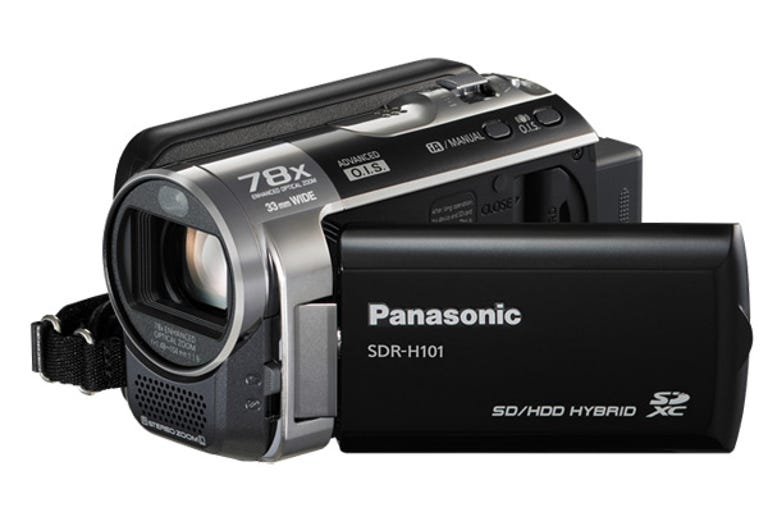 Why You Can Trust CNET
Why You Can Trust CNET Panasonic SDR-H101 review: Panasonic SDR-H101
Panasonic's dual-hard-drive/SD card camcorder delivers average quality. It's not a terrible camcorder, but it's not one that stands out, and the lack of HD recording is a notable omission.
Design
Panasonic's affordable SDR-H101 is a bulky camcorder by most standards (55.1x64.0x107.3mm and 273 grams), but that's because it's a hybrid SD card and hard disk drive model, and all of that technology takes up both space and weight. The physical layout is well balanced, for the most part. We tested the SDR-H101 concurrently with the smaller SD80, and where that camcorder had difficulty in spacing out its record button next to the bulky battery, the designers of the SDR-H101 have allowed a more generous finger spacing. The one consequence of that decision is that the battery juts out from the back of the entire camcorder. It's only an aesthetic thing, but it does look odd.
The Good
The Bad
The Bottom Line
Where many consumer camcorders (including a lot of Panasonic's own range) opt for a touchscreen, the SDR-H101 opts instead for a simple small joystick control on the side of the camcorder's 2.7-inch LCD screen.
Features
With many camcorders — even at the entry level — starting to adopt high-definition recording as standard, it's rather surprising to discover that the SDR-H101 doesn't manage it. That can be a double-edged sword; many low-end "HD" camcorders do a ham-fisted job of high definition anyway, but the SDR-H101 will top out at a 720x576 10Mbps H.264 video capture in XP mode. Those wishing to eke out more video recording time can drop that bit rate to 5Mbps or 2.5Mbps, respectively, in SP and LP modes.
The sensor underlying the SDR-H101's f/1.9 33mm lens is a 1/8-inch CCD with a 0.8-megapixel sensor, 0.41-megapixel effective. This is not a very stunning an option for the more professionally minded crowd, but this is very much an entry-level camcorder, backed up by the same "iA" (Intelligent Auto) shooting mode being the default as we tested on the SD80. The one big difference here is that the SDR-H101 has a dedicated button for the front light, making it a lot easier to manage.
Performance
In ergonomic terms, the SDR-H101 was a pleasure to use; it felt comfortable in the hand, and the essential shooting controls were easy to grasp. It's very much a matter of personal taste as to whether you prefer a touchscreen or joystick control, but we found that the SDR-101's joystick did a good job of menu navigation.
Visual fidelity was mixed. In iA mode, results were mostly solid, although we noticed that the SDR-H101 had distinct problems with lighting correction, not just for using the front LED but also when panning across landscape scenes with variable lighting. It's nothing that we haven't seen from similarly priced camcorders, however. Overall, this is very much a camcorder that delivers passable quality rather than anything that we could call exceptional. With an effective 0.4-megapixel lens, the SDR-H101's still image-capture quality was unsurprisingly uninspiring. You could get better results capturing still frames from much of the video shot on the SDR-H101.
Conclusion
The SDR-H101 is a fair camcorder, but it's not a great one. Our largest gripe with it is really a pricing one. As we tested this concurrently with the SD80, we were able to compare shot quality quite closely. While the SD80 does cost more, the price difference isn't that immense between the two models at RRP, and yet the overall video capture quality is. It's nice to have the choice between hard drive and SD card recording quality, but, ultimately, you'll get better quality out of other camcorders at this kind of price range, making the SDR-H101 a camcorder best picked up as a budget special.


